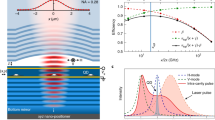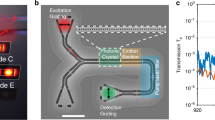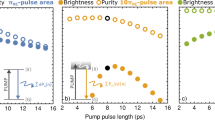Abstract
Photon loss is the biggest problem for scalable photonic quantum information processing. This issue can be tackled through quantum error correction, provided that the overall photon loss is below a threshold of one-third. However, all reported on-demand and indistinguishable single-photon sources still fall short of this threshold. Here, by using tailor shaped laser pulse excitation on a high-quantum efficiency single quantum dot deterministically coupled to a tunable open microcavity, we simultaneously demonstrate a high-performance source with a low multi-photon error of g(2)(0) = 0.0205(6), photon indistinguishability of 0.9856(13) and overall system efficiency of 0.712(18). This source for the first time reaches the efficiency threshold for scalable photonic quantum computing. With this source, we further demonstrate 1.89(14) dB intensity squeezing, and consecutive 40-photon events with a count rate of 1.67 mHz.
This is a preview of subscription content, access via your institution
Access options
Access Nature and 54 other Nature Portfolio journals
Get Nature+, our best-value online-access subscription
27,99 € / 30 days
cancel any time
Subscribe to this journal
Receive 12 print issues and online access
209,00 € per year
only 17,42 € per issue
Buy this article
- Purchase on SpringerLink
- Instant access to full article PDF
Prices may be subject to local taxes which are calculated during checkout




Similar content being viewed by others
Data availability
All data are available from the corresponding author upon reasonable request. Source Data are provided with this paper.
References
Zhong, H.-S. et al. Quantum computational advantage using photons. Science 370, 1460–1463 (2020).
Arute, F. et al. Quantum supremacy using a programmable superconducting processor. Nature 574, 505–510 (2019).
Bernstein, E. & Vazirani, U. Quantum complexity theory. In Proc. 25th Annual ACM Symposium on Theory of Computing 11–20 (ACM, 1993).
Bharti, K. et al. Noisy intermediate-scale quantum algorithms. Rev. Modern Phys. 94, 015004 (2022).
Aharonov, D. & Ben-Or, M. Fault-tolerant quantum computation with constant error. In Proc. 29th Annual ACM Symposium on Theory of Computing 176–188 (ACM, 1997).
Grassl, M., Beth, T. & Pellizzari, T. Codes for the quantum erasure channel. Phys. Rev. A 56, 33 (1997).
Wasilewski, W. & Banaszek, K. Protecting an optical qubit against photon loss. Phys. Rev. A 75, 042316 (2007).
Kieling, K., Rudolph, T. & Eisert, J. Percolation, renormalization, and quantum computing with nondeterministic gates. Phys. Rev. Lett. 99, 130501 (2007).
Gimeno-Segovia, M., Shadbolt, P., Browne, D. E. & Rudolph, T. From three-photon Greenberger–Horne–Zeilinger states to ballistic universal quantum computation. Phys. Rev. Lett. 115, 020502 (2015).
Varnava, M., Browne, D. E. & Rudolph, T. How good must single photon sources and detectors be for efficient linear optical quantum computation? Phys. Rev. Lett. 100, 060502 (2008).
Aspect, A., Grangier, P. & Roger, G. Experimental tests of realistic local theories via Bell’s theorem. Phys. Rev. Lett. 47, 460 (1981).
Zhong, H.-S. et al. Phase-programmable gaussian boson sampling using stimulated squeezed light. Phys. Rev. Lett. 127, 180502 (2021).
Madsen, L. S. et al. Quantum computational advantage with a programmable photonic processor. Nature 606, 75–81 (2022).
Wang, H. et al. Boson sampling with 20 input photons and a 60-mode interferometer in a 1014-dimensional Hilbert space. Phys. Rev. Lett. 123, 250503 (2019).
Zhong, H.-S. et al. 12-photon entanglement and scalable scattershot boson sampling with optimal entangled-photon pairs from parametric down-conversion. Phys. Rev. Lett. 121, 250505 (2018).
Paesani, S. et al. Near-ideal spontaneous photon sources in silicon quantum photonics. Nat. Commun. 11, 2505 (2020).
Kaneda, F. & Kwiat, P. G. High-efficiency single-photon generation via large-scale active time multiplexing. Sci. Adv. 5, eaaw8586 (2019).
Ding, X. et al. On-demand single photons with high extraction efficiency and near-unity indistinguishability from a resonantly driven quantum dot in a micropillar. Phys. Rev. Lett. 116, 020401 (2016).
Wang, H. et al. Towards optimal single-photon sources from polarized microcavities. Nat. Photon. 13, 770–775 (2019).
Tomm, N. et al. A bright and fast source of coherent single photons. Nat. Nanotechnol. 16, 399–403 (2021).
Javadi, A. et al. Cavity-enhanced excitation of a quantum dot in the picosecond regime. New J. Phys. 25, 093027 (2023).
Tomm, N. et al. Tuning the mode splitting of a semiconductor microcavity with uniaxial stress. Phys. Rev. Appl. 15, 054061 (2021).
Weiner, A. M. Femtosecond pulse shaping using spatial light modulators. Rev. Sci. Instruments 71, 1929–1960 (2000).
Mandel, L. Sub-poissonian photon statistics in resonance fluorescence. Optics Lett. 4, 205–207 (1979).
Chu, X.-L., Götzinger, S. & Sandoghdar, V. A single molecule as a high-fidelity photon gun for producing intensity-squeezed light. Nat. Photon. 11, 58–62 (2017).
Wang, H. et al. Observation of intensity squeezing in resonance fluorescence from a solid-state device. Phys. Rev. Lett. 125, 153601 (2020).
Hu, P. et al. Detecting single infrared photons toward optimal system detection efficiency. Optics Exp. 28, 36884 (2020).
Chang, J. et al. Detecting telecom single photons with 99.5(–2.07)(+0.5)% system detection efficiency and high time resolution. APL Photon. 6, 036114 (2021).
Resta, G. V. et al. Gigahertz detection rates and dynamic photon-number resolution with superconducting nanowire arrays. Nano Lett. 23, 6018–6026 (2023).
Zhang, T. et al. Superconducting single-photon detector with a speed of 5 GHz and a photon number resolution of 61. Photon. Res. 12, 1328–1333 (2024).
Hanbury Brown, R. & Twiss, R. Q. in A Source Book in Astronomy and Astrophysics, 1900–1975 8–12 (Harvard Univ. Press, 1979).
Hong, C.-K., Ou, Z.-Y. & Mandel, L. Measurement of subpicosecond time intervals between two photons by interference. Phys. Rev. Lett. 59, 2044 (1987).
Glauber, R. J. The quantum theory of optical coherence. Phys. Rev. 130, 2529 (1963).
Wang, H. et al. Near-transform-limited single photons from an efficient solid-state quantum emitter. Phys. Rev. Let. 116, 213601 (2016).
Kuhlmann, A. V. et al. Transform-limited single photons from a single quantum dot. Nat. Commun. 6, 8204 (2015).
Acknowledgements
Our work is supported by the National Natural Science Foundation of China (grant nos. 12012422 and 62474168), the National Key R&D Program of China (grant no. 2019YFA0308700), the Chinese Academy of Sciences, the Anhui Initiative in Quantum Information Technologies (grant no. AHY060000), the Science and Technology Commission of Shanghai Municipality (grant no. 2019SHZDZX01), the Innovation Program for Quantum Science and Technology (grant no. 2021ZD0301400, 2021ZD0300204), Chinese Academy of Sciences Project for Young Scientists in Basic Research (grant no. YSBR-112) and the China Postdoctoral Science Foundation (grant no. 2021M703102).
Author information
Authors and Affiliations
Contributions
C.-Y.L. and J.-W.P. conceived and designed the experiments. R.-Z.L., J.-Y.Z., Z.-X.G, Q.-H.Z. and Y.-H.H. grew and fabricated the quantum dot samples. M.-C.X. and L.-J.W. fabricated the cavity mirror. G.-Y.Z., H.-L.L., M.-C.C., H.W. and Y.-M.H. contributed materials and analysis tools. X.D. and Y.-P.G. performed the optical experiments. X.D., Y.-P.G. and G.-Y.Z. analysed the experimental data. X.D. and C.-Y.L. wrote the paper with input from all authors. C.-Y.L. and J.-W.P. supervised the project.
Corresponding authors
Ethics declarations
Competing interests
The authors declare no competing interests.
Peer review
Peer review information
Nature Photonics thanks the anonymous reviewers for their contribution to the peer review of this work.
Additional information
Publisher’s note Springer Nature remains neutral with regard to jurisdictional claims in published maps and institutional affiliations.
Supplementary information
Supplementary Information
Supplementary Figs. 1–6, Discussion, and Supplementary Tables 1 and 2.
Rights and permissions
Springer Nature or its licensor (e.g. a society or other partner) holds exclusive rights to this article under a publishing agreement with the author(s) or other rightsholder(s); author self-archiving of the accepted manuscript version of this article is solely governed by the terms of such publishing agreement and applicable law.
About this article
Cite this article
Ding, X., Guo, YP., Xu, MC. et al. High-efficiency single-photon source above the loss-tolerant threshold for efficient linear optical quantum computing. Nat. Photon. 19, 387–391 (2025). https://doi.org/10.1038/s41566-025-01639-8
Received:
Accepted:
Published:
Issue Date:
DOI: https://doi.org/10.1038/s41566-025-01639-8
This article is cited by
-
Ångström-tunable polarization-resolved solid-state photon sources
Nature Photonics (2025)
-
Deterministic and reconfigurable graph state generation with a single solid-state quantum emitter
Nature Communications (2025)
-
Deterministic resonance fluorescence improvement of single quantum dots by optimized surface passivation
Light: Science & Applications (2025)



